Answered step by step
Verified Expert Solution
Question
1 Approved Answer
Questions for Discussion 1. What are the ethical issues in this case? 2. Who are the primary stakeholders in these incidents? 3. What are the
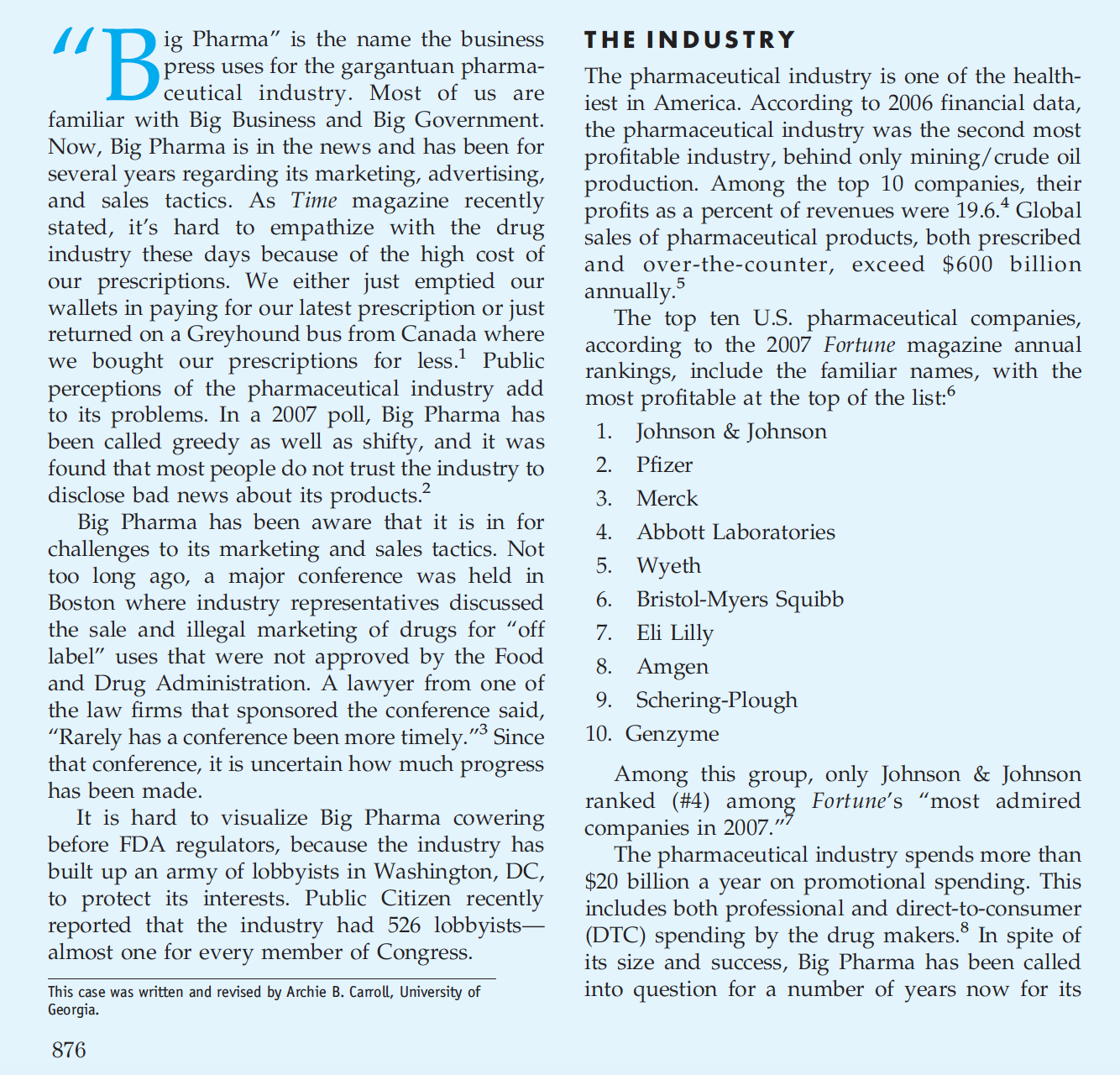
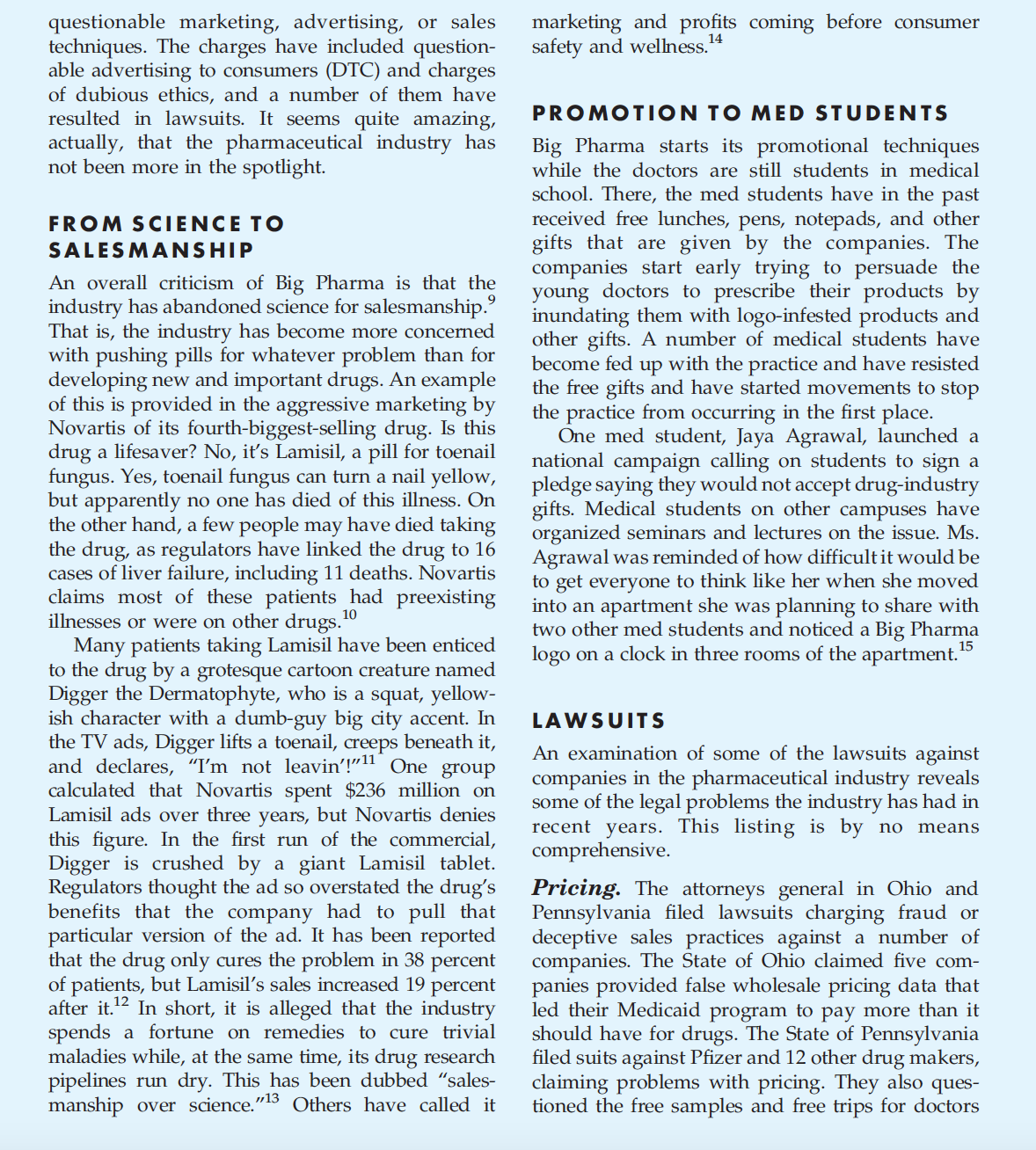
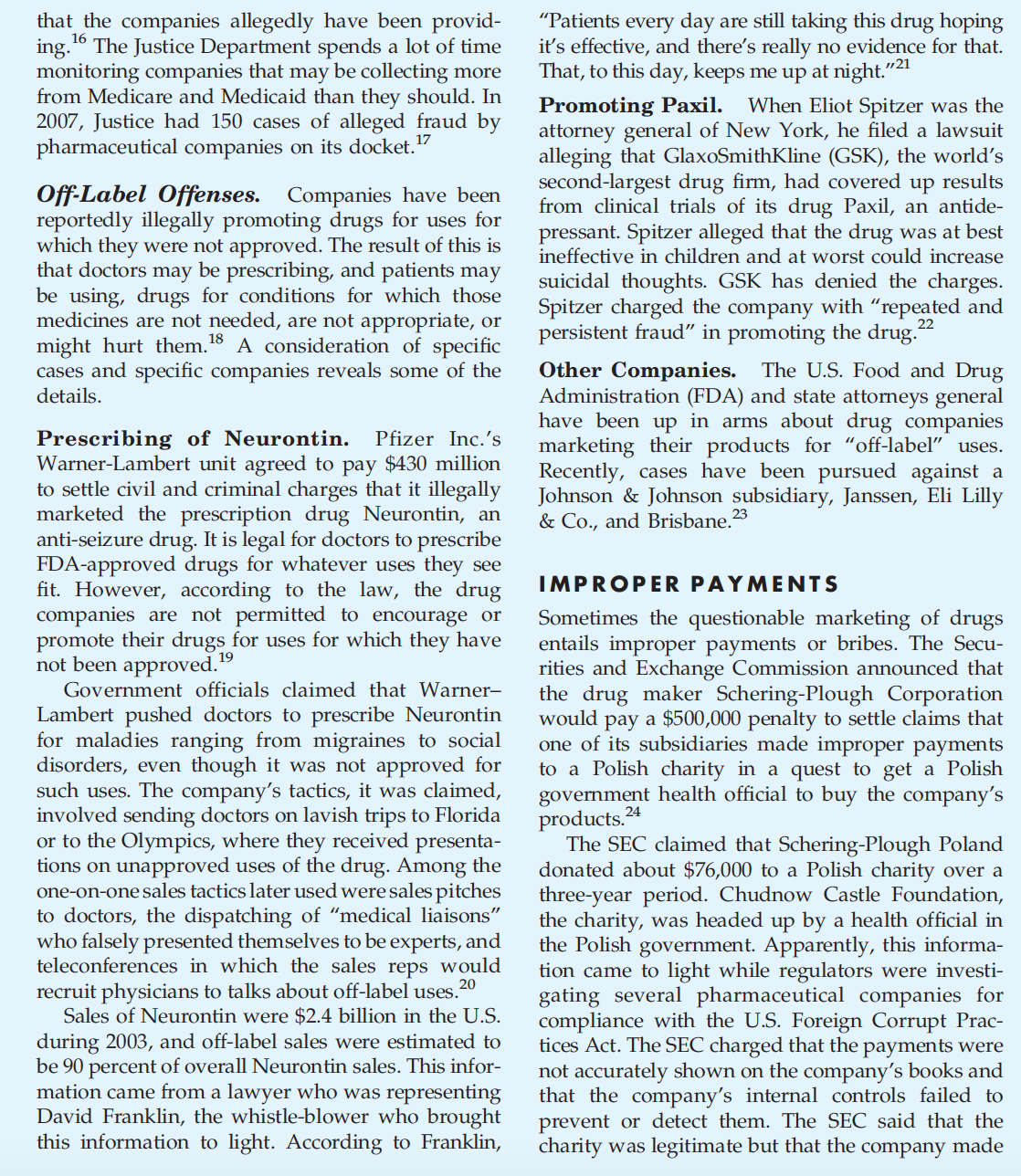
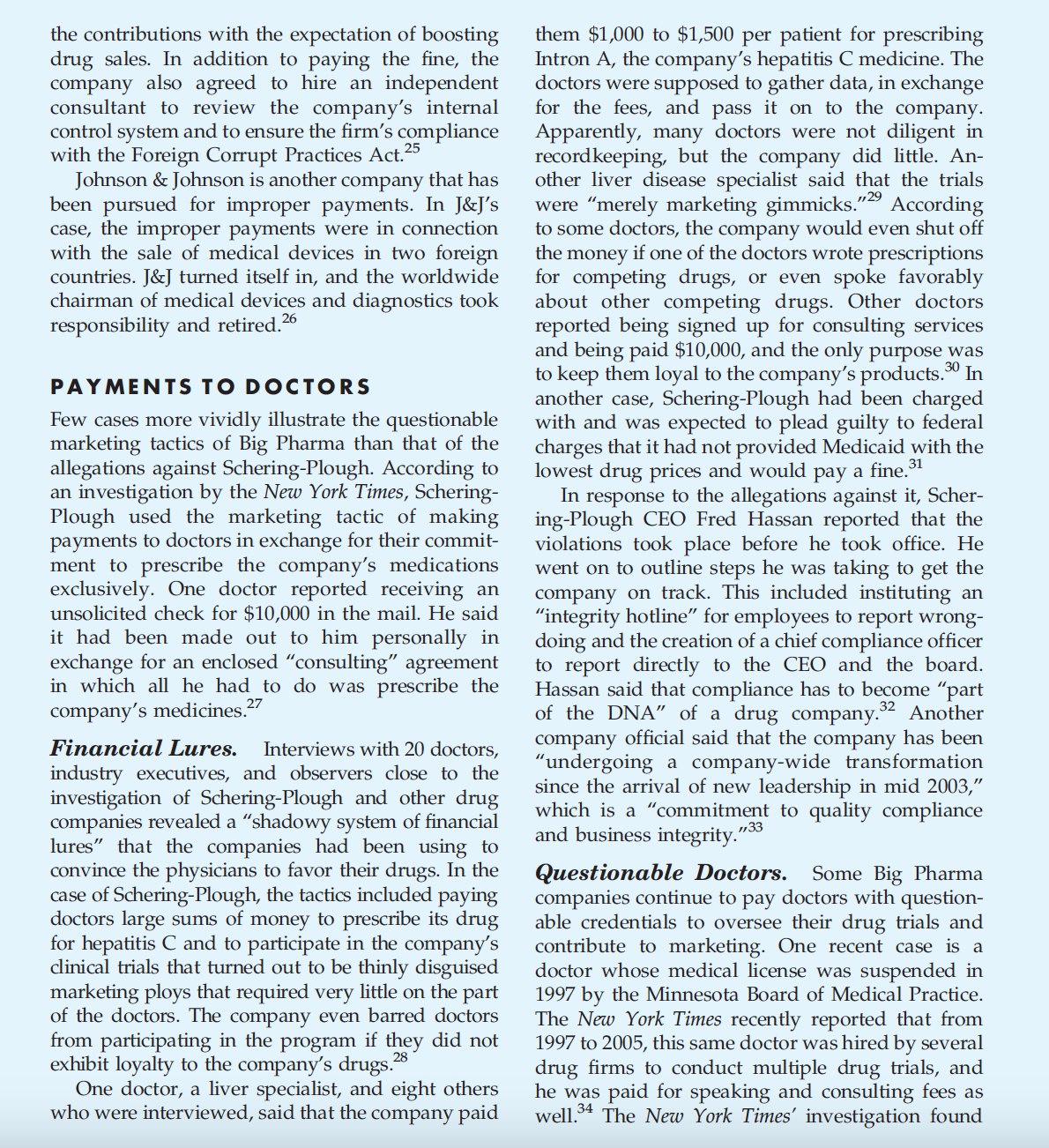
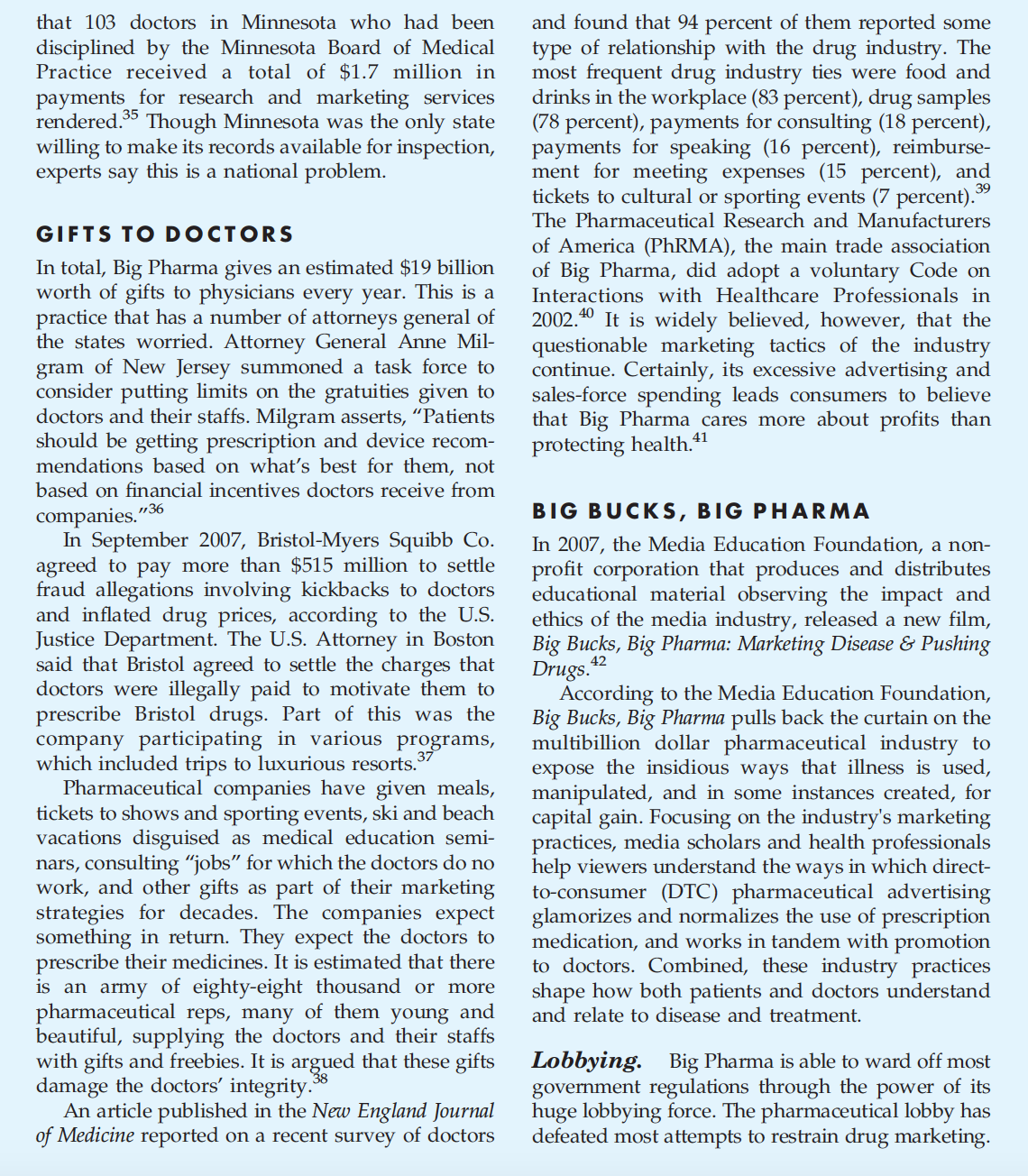
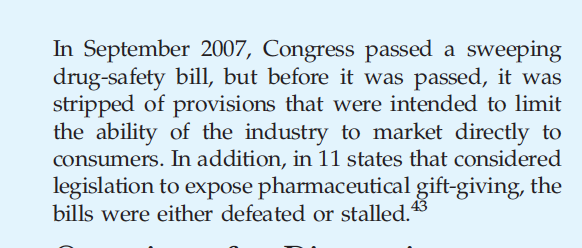
Questions for Discussion
1. What are the ethical issues in this case?
2. Who are the primary stakeholders in these
incidents?
3. What are the proposed alternatives?
4. Which alternatives would best work with utility approach, rights approach and justice approach ? provide justification
44D ig Pharma" is the name the business press uses for the gargantuan pharmaceutical industry. Most of us are familiar with Big Business and Big Government. Now, Big Pharma is in the news and has been for several years regarding its marketing, advertising, and sales tactics. As Time magazine recently stated, it's hard to empathize with the drug industry these days because of the high cost of our prescriptions. We either just emptied our wallets in paying for our latest prescription or just returned on a Greyhound bus from Canada where we bought our prescriptions for less. 1 Public perceptions of the pharmaceutical industry add to its problems. In a 2007 poll, Big Pharma has been called greedy as well as shifty, and it was found that most people do not trust the industry to disclose bad news about its products. 2 Big Pharma has been aware that it is in for challenges to its marketing and sales tactics. Not too long ago, a major conference was held in Boston where industry representatives discussed the sale and illegal marketing of drugs for "off label" uses that were not approved by the Food and Drug Administration. A lawyer from one of the law firms that sponsored the conference said, "Rarely has a conference been more timely." .3 ince that conference, it is uncertain how much progress has been made. It is hard to visualize Big Pharma cowering before FDA regulators, because the industry has built up an army of lobbyists in Washington, DC, to protect its interests. Public Citizen recently reported that the industry had 526 lobbyistsalmost one for every member of Congress. This case was written and revised by Archie B. Carroll, University of Georgia. THE INDUSTRY The pharmaceutical industry is one of the healthiest in America. According to 2006 financial data, the pharmaceutical industry was the second most profitable industry, behind only mining/crude oil production. Among the top 10 companies, their profits as a percent of revenues were 19.6.4 Global sales of pharmaceutical products, both prescribed and over-the-counter, exceed $600 billion annually. 5 The top ten U.S. pharmaceutical companies, according to the 2007 Fortune magazine annual rankings, include the familiar names, with the most profitable at the top of the list: 6 1. Johnson \& Johnson 2. Pfizer 3. Merck 4. Abbott Laboratories 5. Wyeth 6. Bristol-Myers Squibb 7. Eli Lilly 8. Amgen 9. Schering-Plough 10. Genzyme Among this group, only Johnson \& Johnson ranked (\#4) among Fortune's "most admired companies in 2007." The pharmaceutical industry spends more than $20 billion a year on promotional spending. This includes both professional and direct-to-consumer (DTC) spending by the drug makers. 8 In spite of its size and success, Big Pharma has been called into question for a number of years now for its 876 questionable marketing, advertising, or sales techniques. The charges have included questionable advertising to consumers (DTC) and charges of dubious ethics, and a number of them have resulted in lawsuits. It seems quite amazing, actually, that the pharmaceutical industry has not been more in the spotlight. FROM SCIENCE TO SALESMANSHIP An overall criticism of Big Pharma is that the industry has abandoned science for salesmanship. 9 That is, the industry has become more concerned with pushing pills for whatever problem than for developing new and important drugs. An example of this is provided in the aggressive marketing by Novartis of its fourth-biggest-selling drug. Is this drug a lifesaver? No, it's Lamisil, a pill for toenail fungus. Yes, toenail fungus can turn a nail yellow, but apparently no one has died of this illness. On the other hand, a few people may have died taking the drug, as regulators have linked the drug to 16 cases of liver failure, including 11 deaths. Novartis claims most of these patients had preexisting illnesses or were on other drugs. 10 Many patients taking Lamisil have been enticed to the drug by a grotesque cartoon creature named Digger the Dermatophyte, who is a squat, yellowish character with a dumb-guy big city accent. In the TV ads, Digger lifts a toenail, creeps beneath it, and declares, "I'm not leavin'!"11 One group calculated that Novartis spent \$236 million on Lamisil ads over three years, but Novartis denies this figure. In the first run of the commercial, Digger is crushed by a giant Lamisil tablet. Regulators thought the ad so overstated the drug's benefits that the company had to pull that particular version of the ad. It has been reported that the drug only cures the problem in 38 percent of patients, but Lamisil's sales increased 19 percent after it. 12 In short, it is alleged that the industry spends a fortune on remedies to cure trivial maladies while, at the same time, its drug research pipelines run dry. This has been dubbed "salesmanship over science."13 Others have called it marketing and profits coming before consumer safety and wellness. 14 PROMOTIONTO MED STUDENTS Big Pharma starts its promotional techniques while the doctors are still students in medical school. There, the med students have in the past received free lunches, pens, notepads, and other gifts that are given by the companies. The companies start early trying to persuade the young doctors to prescribe their products by inundating them with logo-infested products and other gifts. A number of medical students have become fed up with the practice and have resisted the free gifts and have started movements to stop the practice from occurring in the first place. One med student, Jaya Agrawal, launched a national campaign calling on students to sign a pledge saying they would not accept drug-industry gifts. Medical students on other campuses have organized seminars and lectures on the issue. Ms. Agrawal was reminded of how difficult it would be to get everyone to think like her when she moved into an apartment she was planning to share with two other med students and noticed a Big Pharma logo on a clock in three rooms of the apartment. 15 LAWSUITS An examination of some of the lawsuits against companies in the pharmaceutical industry reveals some of the legal problems the industry has had in recent years. This listing is by no means comprehensive. Pricing. The attorneys general in Ohio and Pennsylvania filed lawsuits charging fraud or deceptive sales practices against a number of companies. The State of Ohio claimed five companies provided false wholesale pricing data that led their Medicaid program to pay more than it should have for drugs. The State of Pennsylvania filed suits against Pfizer and 12 other drug makers, claiming problems with pricing. They also questioned the free samples and free trips for doctors that the companies allegedly have been providing. 16 The Justice Department spends a lot of time monitoring companies that may be collecting more from Medicare and Medicaid than they should. In 2007, Justice had 150 cases of alleged fraud by pharmaceutical companies on its docket. 17 Off-Label Offenses. Companies have been reportedly illegally promoting drugs for uses for which they were not approved. The result of this is that doctors may be prescribing, and patients may be using, drugs for conditions for which those medicines are not needed, are not appropriate, or might hurt them. 18A consideration of specific cases and specific companies reveals some of the details. Prescribing of Neurontin. Pfizer Inc.'s Warner-Lambert unit agreed to pay $430 million to settle civil and criminal charges that it illegally marketed the prescription drug Neurontin, an anti-seizure drug. It is legal for doctors to prescribe FDA-approved drugs for whatever uses they see fit. However, according to the law, the drug companies are not permitted to encourage or promote their drugs for uses for which they have not been approved. 19 Government officials claimed that WarnerLambert pushed doctors to prescribe Neurontin for maladies ranging from migraines to social disorders, even though it was not approved for such uses. The company's tactics, it was claimed, involved sending doctors on lavish trips to Florida or to the Olympics, where they received presentations on unapproved uses of the drug. Among the one-on-one sales tactics later used were sales pitches to doctors, the dispatching of "medical liaisons" who falsely presented themselves to be experts, and teleconferences in which the sales reps would recruit physicians to talks about off-label uses. 20 Sales of Neurontin were $2.4 billion in the U.S. during 2003, and off-label sales were estimated to be 90 percent of overall Neurontin sales. This information came from a lawyer who was representing David Franklin, the whistle-blower who brought this information to light. According to Franklin, "Patients every day are still taking this drug hoping it's effective, and there's really no evidence for that. That, to this day, keeps me up at night."21 Promoting Paxil. When Eliot Spitzer was the attorney general of New York, he filed a lawsuit alleging that GlaxoSmithKline (GSK), the world's second-largest drug firm, had covered up results from clinical trials of its drug Paxil, an antidepressant. Spitzer alleged that the drug was at best ineffective in children and at worst could increase suicidal thoughts. GSK has denied the charges. Spitzer charged the company with "repeated and persistent fraud" in promoting the drug. 22 Other Companies. The U.S. Food and Drug Administration (FDA) and state attorneys general have been up in arms about drug companies marketing their products for "off-label" uses. Recently, cases have been pursued against a Johnson \& Johnson subsidiary, Janssen, Eli Lilly \& Co., and Brisbane. 23 IMPROPER PAYMENTS Sometimes the questionable marketing of drugs entails improper payments or bribes. The Securities and Exchange Commission announced that the drug maker Schering-Plough Corporation would pay a $500,000 penalty to settle claims that one of its subsidiaries made improper payments to a Polish charity in a quest to get a Polish government health official to buy the company's products. 24 The SEC claimed that Schering-Plough Poland donated about $76,000 to a Polish charity over a three-year period. Chudnow Castle Foundation, the charity, was headed up by a health official in the Polish government. Apparently, this information came to light while regulators were investigating several pharmaceutical companies for compliance with the U.S. Foreign Corrupt Practices Act. The SEC charged that the payments were not accurately shown on the company's books and that the company's internal controls failed to prevent or detect them. The SEC said that the charity was legitimate but that the company made the contributions with the expectation of boosting drug sales. In addition to paying the fine, the company also agreed to hire an independent consultant to review the company's internal control system and to ensure the firm's compliance with the Foreign Corrupt Practices Act. 25 Johnson \& Johnson is another company that has been pursued for improper payments. In J\&J's case, the improper payments were in connection with the sale of medical devices in two foreign countries. J\&J turned itself in, and the worldwide chairman of medical devices and diagnostics took responsibility and retired. 26 PAYMENTS TO DOCTORS Few cases more vividly illustrate the questionable marketing tactics of Big Pharma than that of the allegations against Schering-Plough. According to an investigation by the New York Times, ScheringPlough used the marketing tactic of making payments to doctors in exchange for their commitment to prescribe the company's medications exclusively. One doctor reported receiving an unsolicited check for $10,000 in the mail. He said it had been made out to him personally in exchange for an enclosed "consulting" agreement in which all he had to do was prescribe the company's medicines. 27 Financial Lures. Interviews with 20 doctors, industry executives, and observers close to the investigation of Schering-Plough and other drug companies revealed a "shadowy system of financial lures" that the companies had been using to convince the physicians to favor their drugs. In the case of Schering-Plough, the tactics included paying doctors large sums of money to prescribe its drug for hepatitis C and to participate in the company's clinical trials that turned out to be thinly disguised marketing ploys that required very little on the part of the doctors. The company even barred doctors from participating in the program if they did not exhibit loyalty to the company's drugs. 28 One doctor, a liver specialist, and eight others who were interviewed, said that the company paid them $1,000 to $1,500 per patient for prescribing Intron A, the company's hepatitis C medicine. The doctors were supposed to gather data, in exchange for the fees, and pass it on to the company. Apparently, many doctors were not diligent in recordkeeping, but the company did little. Another liver disease specialist said that the trials were "merely marketing gimmicks." 29 According to some doctors, the company would even shut off the money if one of the doctors wrote prescriptions for competing drugs, or even spoke favorably about other competing drugs. Other doctors reported being signed up for consulting services and being paid $10,000, and the only purpose was to keep them loyal to the company's products. 30In another case, Schering-Plough had been charged with and was expected to plead guilty to federal charges that it had not provided Medicaid with the lowest drug prices and would pay a fine. 31 In response to the allegations against it, Schering-Plough CEO Fred Hassan reported that the violations took place before he took office. He went on to outline steps he was taking to get the company on track. This included instituting an "integrity hotline" for employees to report wrongdoing and the creation of a chief compliance officer to report directly to the CEO and the board. Hassan said that compliance has to become "part of the DNA" of a drug company. 32 Another company official said that the company has been "undergoing a company-wide transformation since the arrival of new leadership in mid 2003," which is a "commitment to quality compliance and business integrity." Questionable Doctors. Some Big Pharma companies continue to pay doctors with questionable credentials to oversee their drug trials and contribute to marketing. One recent case is a doctor whose medical license was suspended in 1997 by the Minnesota Board of Medical Practice. The New York Times recently reported that from 1997 to 2005 , this same doctor was hired by several drug firms to conduct multiple drug trials, and he was paid for speaking and consulting fees as well. 34 The New York Times' investigation found that 103 doctors in Minnesota who had been disciplined by the Minnesota Board of Medical Practice received a total of $1.7 million in payments for research and marketing services rendered. 35 Though Minnesota was the only state willing to make its records available for inspection, experts say this is a national problem. GIFTSTO DOCTORS In total, Big Pharma gives an estimated $19 billion worth of gifts to physicians every year. This is a practice that has a number of attorneys general of the states worried. Attorney General Anne Milgram of New Jersey summoned a task force to consider putting limits on the gratuities given to doctors and their staffs. Milgram asserts, "Patients should be getting prescription and device recommendations based on what's best for them, not based on financial incentives doctors receive from companies." 36 In September 2007, Bristol-Myers Squibb Co. agreed to pay more than $515 million to settle fraud allegations involving kickbacks to doctors and inflated drug prices, according to the U.S. Justice Department. The U.S. Attorney in Boston said that Bristol agreed to settle the charges that doctors were illegally paid to motivate them to prescribe Bristol drugs. Part of this was the company participating in various programs, which included trips to luxurious resorts. 37 Pharmaceutical companies have given meals, tickets to shows and sporting events, ski and beach vacations disguised as medical education seminars, consulting "jobs" for which the doctors do no work, and other gifts as part of their marketing strategies for decades. The companies expect something in return. They expect the doctors to prescribe their medicines. It is estimated that there is an army of eighty-eight thousand or more pharmaceutical reps, many of them young and beautiful, supplying the doctors and their staffs with gifts and freebies. It is argued that these gifts damage the doctors' integrity. 38 An article published in the New England Journal of Medicine reported on a recent survey of doctors and found that 94 percent of them reported some type of relationship with the drug industry. The most frequent drug industry ties were food and drinks in the workplace (83 percent), drug samples (78 percent), payments for consulting (18 percent), payments for speaking (16 percent), reimbursement for meeting expenses (15 percent), and tickets to cultural or sporting events (7 percent). 39 The Pharmaceutical Research and Manufacturers of America (PhRMA), the main trade association of Big Pharma, did adopt a voluntary Code on Interactions with Healthcare Professionals in 2002.40 It is widely believed, however, that the questionable marketing tactics of the industry continue. Certainly, its excessive advertising and sales-force spending leads consumers to believe that Big Pharma cares more about profits than protecting health. 41 BIG BUCKS, BIG PHARMA In 2007, the Media Education Foundation, a nonprofit corporation that produces and distributes educational material observing the impact and ethics of the media industry, released a new film, Big Bucks, Big Pharma: Marketing Disease \& Pushing Drugs. 42 According to the Media Education Foundation, Big Bucks, Big Pharma pulls back the curtain on the multibillion dollar pharmaceutical industry to expose the insidious ways that illness is used, manipulated, and in some instances created, for capital gain. Focusing on the industry's marketing practices, media scholars and health professionals help viewers understand the ways in which directto-consumer (DTC) pharmaceutical advertising glamorizes and normalizes the use of prescription medication, and works in tandem with promotion to doctors. Combined, these industry practices shape how both patients and doctors understand and relate to disease and treatment. Lobbying. Big Pharma is able to ward off most government regulations through the power of its huge lobbying force. The pharmaceutical lobby has defeated most attempts to restrain drug marketing. In September 2007, Congress passed a sweeping drug-safety bill, but before it was passed, it was stripped of provisions that were intended to limit the ability of the industry to market directly to consumers. In addition, in 11 states that considered legislation to expose pharmaceutical gift-giving, the bills were either defeated or stalled. 43Step by Step Solution
There are 3 Steps involved in it
Step: 1

Get Instant Access to Expert-Tailored Solutions
See step-by-step solutions with expert insights and AI powered tools for academic success
Step: 2

Step: 3

Ace Your Homework with AI
Get the answers you need in no time with our AI-driven, step-by-step assistance
Get Started


